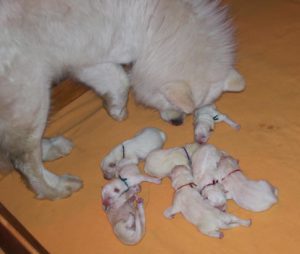General Information

Samoyed Breed Information
WHEN CONSIDERING A SAMOYED – INFORMATION YOU NEED TO KNOW!
First and foremost – Samoyeds are NOT hypoallergenic!
Dog Allergies – This is always an interesting discussion, and the internet is not helpful and full of misinformation – unfortunately Samoyeds are NOT a hypoallergenic dog. Some breeds are less of a trigger than others, like Samoyeds – they typically do not create the same level of reaction as a Labrador, Doberman, or Pug. But, Samoyeds do shed a LOT, and thus create lots of dander, so they will trigger allergies.
The best way to determine how severe a reaction anyone may have to a Samoyed is to arrange to visit the home of a Samoyed breeder and interact with the dogs, their coat, the dander in the air, etc. HOWEVER: each dog is different, and there is no way of knowing if any particular puppy will create an allergic reaction or not – their coat changes three-to-four times during their lives, and as they get older, they can become more of an allergen. I sold a puppy to one home with MILD allergies as a puppy – now at age 6, the dog is no longer allowed to sleep on the furniture or in their bedroom due to the husband’s change in response to the dog’s coat.
I do not recommend a Samoyed in a house with allergies. I do Samoyed Rescue for most of Canada, and we do our fair share of finding new homes for Samoyeds that their owners need to surrender due to allergies.
Here is a link to the Samoyed Association of Canada site, with links to articles on ‘hypoallergenic dogs’ – if that helps at all.
And if someone has a dog-saliva allergy, than it won’t matter what breed of dog it is.
When considering a Samoyed, and any potential allergies, remember that Samoyeds are first and foremost ‘family’ dogs. They were bred by the Nenet tribe of northern Russia, in Siberia, which is a nomadic tribe that follows the reindeer herds over the frozen arctic tundra. The dogs are used as guardians and semi-herders during the day, running and working ALL DAY, and then are invited into the tents to be with the family in the evenings and overnight, providing warmth and their fur for clothing and insulation.
A Samoyed is NOT an ‘outside’ dog, i.e. one that can ‘live’ outside. He MUST be part of your home, sleeping indoors, living indoors, and being with his people. He does LOVE outside, but ONLY of you go with him. If you are planning on a Samoyed, you MUST be willing to share your entire space with him.
A Samoyed left alone outside will become highly destructive, barking incessantly, digging everywhere, and will eventually become an escape artist – all in an effort to find a pack or family he can be part of. I have done enough Samoyed breed Rescue to know that there is a belief out there that they can be kept outside, and when all these bad habits become too much for the owners, we end up with them in Rescue.
WHEN BUYING A PUPPY
First, information about dealing with a Responsible Breeder, which is a breeder that isn’t breeding for money, but for the love of the breed and providing good quality healthy dogs. Responsible Breeders (myself included) ensure that their puppies have had their first set of vaccinations (done between 7 and 8 weeks of age) before they go to their new homes, including a full vet check, and are required to have their puppies tattooed or microchipped prior to leaving the breeder’s home, as well as being CKC registered.
Typically you would have to fill out a Puppy Questionnaire for the Breeder, and then be put on a ‘waiting list’. Once you have completed the Puppy Questionnaire, the breeder will contact you with follow up questions, etc.
In some cases you would need to put a deposit down for the puppy before it is born. In my case, I ask for a 50% deposit when it is confirmed the girl is actually pregnant, which is 30 days after she’s been bred. Deposits for my puppies are fully refundable if there is not a puppy for you, or you change your mind, etc. Each breeder is a little different. Some breeders will ask for a deposit before they actually breed their girl, some don’t refund at all – just ask up front for all the details before handing over your money – make sure you are comfortable with the arrangement.
Before I commit a puppy to you, or ask for a deposit, I need to meet you and visit you and see you interact with my dogs – I do not sell puppies without meeting you, and I do not ship puppies. Once the puppy is old enough to go to their new home, you must come and get them. Again, each breeder is different – some will ship puppies, others don’t need to meet you, etc.
Lastly, you should be able to ask the Breeder for several things as well. You should ask to see the Breeder’s Puppy Contract to ensure you all agree on the sale terms and conditions with the puppy. This Contract should include the price, the spay/neuter requirements, warranty (the Breeder’s commitment to the puppy’s health), and Right to Re-Purchase (the Breeder should always be willing to take the puppy/dog back under any circumstances), and Care and Well being responsibilities for you with the puppy.
Many Responsible Breeders have other terms and conditions in their contracts as well; each breeder is different. Other breeders have specific requirements that you must adhere to – you must show the dog, cannot spay/neuter, etc. Make sure you are comfortable with the contract. Most Responsible Breeders place their wonderful companion puppies in quality homes – ‘show’ puppies are usually kept by the Breeder.
You should also see the health clearances on the parents of the dogs. There is a public database that you can access where you can confirm the health clearances on the dogs and the breeder, referred as OFA. “OFA” stands for Orthopedic Foundation for Animals, and you can find their website here: https://www.ofa.org/ The information on the recommended health testing for Samoyeds can be found here: https://www.ofa.org/recommended-tests?breed=SA.
Please note that contrary to some reports, COVID has NOT prevented ongoing health testing – veterinarians, including specialists, are still open and available to ensure breeders continue to health test their breeding dogs so they can produce good quality puppies that can be backed up by a good Puppy Contract. Current expected health clearances are OFA Hips (to ensure they are clear of hip dysplasia), OFA Eyes (to ensure they are clear of the several hereditary eye issues that Samoyeds have), and OFA Cardio (to ensure they are clear of genetic heart issues).
Responsible Breeders should be members in good standing of at least one breed club, for example the Samoyed Association of Canada, or the Samoyed Club of America. In addition, they should also be members of the Canadian Kennel Club. These clubs all have a Code of Ethics that the breeder agrees to and follows to ensure that they meet minimum health and care standards. Here is a link to a list of breeders that are all members in good standing with the Samoyed Association of Canada, and all of these Responsible Breeders have committed to the Code of Ethics to protect the quality of the breed and commit to responsible breeding (including health testing), quality care in the raising of puppies and general overall dog care practices: http://samoyed.ca/sac-breeders.
Here is another informative link to review during your search: https://www.ckc.ca/en/The-Dish/March-2019/How-To-Spot-A-Responsible-Breeder?fbclid=IwAR2YXKgSrRWq_0bbT-vcBSK34w_Z60TycH2eq90qq3930UHN5sVEY-3ZHd8#.XxiJY5BLoZA.facebook
Lastly, here are a couple of very good sites with some overall info on the breed:
If you are considering buying a Samoyed puppy, or any purebred puppy, PLEASE do your homework on the breeder. You should feel ‘interviewed’ and approved as a suitable home, not just a money provider for the breeder. Also, do your homework on the health of the dogs, and demand certificates proving their clearances. Aside from hips and eye problems, Samoyeds can also have epilepsy, diabetes, cardio (heart) issues, and other debilitating health issues that can affect the life and quality of your dog.
IF YOU ARE CONSIDERING BEING A BREEDER YOURSELF
To start with, ‘breeding dogs’ can be complicated, and the original ‘up front’ investment is usually quite significant. You have to start with a good quality female, which NO breeder in their right mind would sell to you – they keep the good ones for themselves! You need to ‘befriend’ a breeder who will ‘share’ a good quality girl with you to start with – in other words, find a good, Responsible mentor. The goal is to become a RESPONSIBLE breeder, one that DOES NOT make money by selling puppies, but rather a breeder that homes puppies and breeds to improve the breed.
If you just want to make money by making and selling puppies, please find something else to do with your time. I will end up taking your puppies into our Rescue – eventually.
Samoyeds are NOT a popular breed, are very care-intensive, require extensive grooming, they dig, they bark, are high energy, and are NOT easy dogs to live with. They were bred by the Nenet tribe of northern Russia, in Siberia, which is a nomadic tribe that follows the reindeer herds over the frozen arctic tundra. The dogs are used as guardians and semi-herders during the day, running and working ALL DAY, and then are invited into the tents to be with the family in the evenings and overnight, providing warmth and their fur for clothing and insulation. They are not an ‘outside’ dog – they cannot live outside by themselves – they MUST be part of your home and life everyday – they are extremely social and require lots of attention.
A breeding program requires one good female to start with, and usually within the first 2-3 years, you will wind up having several in your home – you breed for yourself first, planning on keeping at least one from each litter to carry on the bloodline, meaning that eventually you will have several. You need the room, time, and commitment to do so.
Furthermore, if one wants to breed dogs, one should understand what makes a good one – Responsible Breeders make sure that they show their breeding stock to their Championship titles, to prove their quality, and do all required health clearances to ensure they are breeding good quality healthy stock. This goes not just for the dogs one starts with but is ongoing with the dogs one produces and continues to breed with, and health clearances like eyes, are ongoing and need to be tested each and every year for the same dog – not just one time expenses.
Testing for hips is a one-time expense, and is around $200 per dog. Eye testing and clearances should be done every year, at a cost of $50 per dog, per test. As a result of the cost of constantly showing your dogs to prove quality, and ongoing health clearance requirements, one does not breed dogs to make any money – it is an expensive hobby, done for the love of the breed – not as a business venture!
In addition to hips and eyes, certain bloodlines in Samoyeds are known to have or carry other genetic health issues such as diabetes, epilepsy, cardio (heart) issues, thyroid disorders, liver disorders, skin and coat disorders, and temperament issues. Responsible Breeders test for these and remove any dogs that may carry or have these issues from their breeding programs.
Having puppies is usually quite a process, and even when things go well, there are significant expenses. First there is the stud fee, normally the price of one puppy, followed by vet visits with the mother to ensure she is healthy and check her pregnancy status along the way, followed by top quality food and care before the puppies are born.
There is the whelping box to build/buy, supplies (towels, blankets, puppy first aid kit, neo-natal first aid kit, warming box, milk supplements, etc.), and the long distance calls and time spent on the computer and e-mails to potential puppy buyers. Once the puppies are born, there is ongoing food for the mother, vet bills for their 1st set of vaccinations at 6-7 weeks; also microchips from Canadian Kennel Club (CKC) and the vet fee for implanting them.
Then comes the food. The average Samoyed litter is 5-6 puppies – when they are eating 4 times a day, good quality food gets costly!
Additional expenses include the registration fees to register the litter with CKC, then each individual puppy registration fee once they are sold and the new owners have signed the paperwork, as well as expenses for an appropriate ‘Puppy Package’ including paper and ink for puppy Sales Contracts, binders, photos, or CD’s with photos, etc. Of course all of this is only if you are a RESPONSIBLE Breeder, and things go well.
When things don’t go so well, there are emergency vet visits, c-sections, ‘foster moms’ (God forbid), up every hour to hand feed the puppies for the first 3-4 weeks of their lives, and even then there is no guarantee of survival for some of them.
Then you have the hours and hours of time you need to spend with the litter before they go to their homes at 8 weeks of age; socializing, training, playing – a litter usually takes an additional 6 – 8 hours of your day, every day – doesn’t matter if you are working full time or not. Don’t forget to consider the newspaper or newsprint for all the poop – each puppy poops once for every meal – given even 5 puppies at 4 meals a day – that’s 20 poops per day, not including the mother. (Forget about counting pees!!)
Then there is the true definition of a Responsible Breeder – you accept it that each puppy you produce, no matter where it is sold, is YOUR responsibility for LIFE. Responsible Breeders take back ANY puppy they’ve bred at any time during the dog’s natural life, usually for any reason. I know multiple breeders that took back senior dogs (over 10 years old) due to ‘life’ circumstances for the owners. Breeder re-homes are very common – it doesn’t always work out in the homes you sell to – as they say, ‘LIFE happens’ in some cases. So, you have to interview and scrutinize each person that wants to buy one of your puppies, and they must be APPROVED. You have to be prepared to say NO to someone who wants to buy a puppy – it’s about the puppy and his life, not about your bank account.
Lastly, you should belong to at least one ‘breed club’; the Samoyed Association of Canada, Samoyed Club of America, or other local breed associations. Belonging to breed associations helps ensure that one keeps up on whatever breed related health issues may be discovered, as well as keeping current with other trends in the breed and is another way to compare one’s own breeding stock with what is correct for the breed, as well, and is a way to keep in touch with other breeders and fanciers on any other breed related issues that may be out there.
You have to do your research on the breed, know what you are looking for in the breed, and be able to honestly say why you want to breed. Having puppies is messy, time consuming, and expensive – and WORK. If you are making money and it’s not hard work, then you are doing it wrong and you are not a Responsible breeder.




